The Prince Consort class were wooden-hulled ironclad types, converted from 91-guns two-deckers of the Bulwark class, the HMS Royal Oak on one hand and the HMS Prince Consort, HMS Ocean, and HMS Caledonia. HMS Royal Oak became Britain’s 5th ironclad completed. Prince Consort, Ocean, and Caledonia were built to a common design and are today known as the Prince Consort class, though contemporaries knew them as the Caledonia class. Royal Oak was their half-sister. They rolled and lot and were not very successful, discarded in the 1880s.
Design of the class
Origins
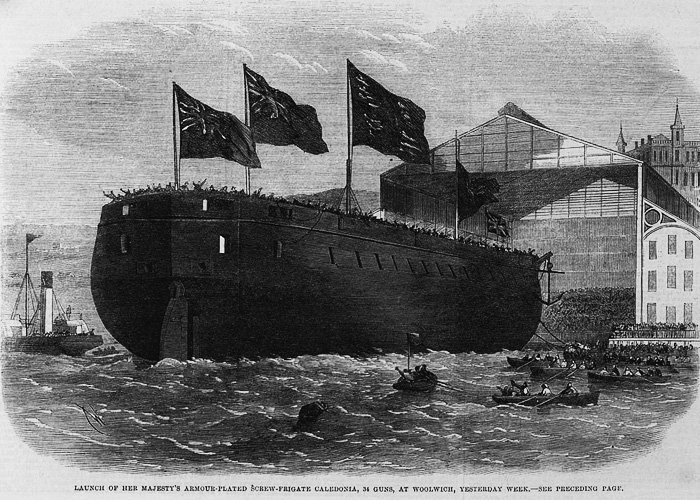
Launch of HMS Caledonia at Woolwich, yesterday week.
The Bulwark class was originally ordered as nine 91-gun two-decker Bulwark class steam-powered line-of-battle ships. They followed the steam-conversion/construction race between England and France, following the Napoleon in 1850. They were laid down between March 1859 and October 1860 with a further three ordered, but never laid down and eventually cancelled in 1863.
Dimensions were the same as HMS Duncan (101 guns), but with a new timbering plan better adapted to a smaller armament. This reduction was intended to improve efficiency. Bulwark and Robust were suspended in March 1861 while in an already advanced state of construction. They were eventually broken up in March 1873 and August 1872. The remaining seven were less well completed and better suite for a conversion into ‘ironclad frigates’ decided in 1860 after the French launched the Gloire class and a new race was on. Triumph (later Prince Consort), Ocean, and Caledonia were thus converted to as broadside ironclads and given new 1,000 nhp engines. Royal Oak was given a similar conversion but kept her older 800 hp engine. Royal Alfred, Zealous and Repulse were later converted as central battery ships (next on our study).
This crash conversion program was commented by Rear Admiral Sir Baldwin Wake Walker as the following:
“They must be regarded as an addition to our force, as a balance to those of France, and not as calculated to supersede any existing class of ship; indeed no prudent man would, at present, consider it safe to risk up the performance of ships of this novel character, the naval Supremacy of Great Britain.”
Peculiarities
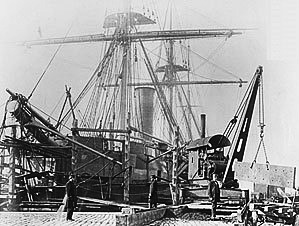 Their conversion from 91-gun Second Rates, to ironclad frigates, was approved in 1861. They ended as half sisters to Royal Oak but with a similar conversion except for the provision of increased machinery power to secure greater speed. They were unsuccessful because the extra weight of the machinery cancelled the advantages of the extra power. Furthermore, they were in fact slower than Royal Oak. The completion of Caledonia was delayed by the late arrival of her armament.
Their conversion from 91-gun Second Rates, to ironclad frigates, was approved in 1861. They ended as half sisters to Royal Oak but with a similar conversion except for the provision of increased machinery power to secure greater speed. They were unsuccessful because the extra weight of the machinery cancelled the advantages of the extra power. Furthermore, they were in fact slower than Royal Oak. The completion of Caledonia was delayed by the late arrival of her armament.
The conversion from 91-guns ships of the line to ironclad frigates was not an easy task. The two-decked wooden ship had their sides cut down considerably, main deck and battery removed and if the armour weighted as much as what was removed, the ship “sunk” still, having a slightly lower waterline whereas stability was greater, as they were found less top-heavy and brought down the centre of gravity (lower metacentric height).
They also were lengthened by 21 feet, not only to provide more space for a new armament on a single deck (except for chase guns) and give them a better shaped hull as a Frigate, so better speed. These extensions were carried out by cutting their hull in at the greatest beam, inserting a new section between them. Prince Consort, Caledonia, Ocean, Royal Alfred and Royal Oak each had a new 23 feet section inserted at the midship portion and since it was the subject of most sagging and hogging strains, special care ensure this inserted section was strongly built, specially as it was to support larger engines as previously planned. Exceptionally stout timbering was used, and it had a full bilge throughout, reworked floors.
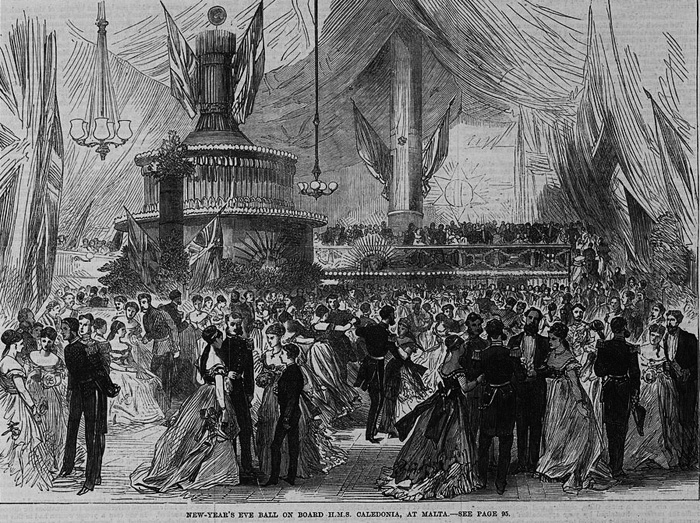
New Year’s Eve ball on HMS Caledonia, 31 Dec. 1868 at Malta
The bows went from knee-shape to straight, pointy stems approaching the upright above water, a style that won aesthetic approval. They lacked underwater rams.
The stern was also modified to protect the rudder-head and deflect raking shot as well as betetr deflect following waves and reduce drag. The overhang was narrowed to an oval termination. This gave them a new appearance, called ‘double-enders’. There was still a wooden rudder, of the old narrow unbalanced type, with a bronze neck socket, but was modified for double-tillered norman head.
They lacked any double bottom or water-tight bulkheads, albeit their bottoms were very thick, from experience in groundings of heavy 1st and 2nd rate ships of the line. However it was thin enough to be liable to penetration by a rock, reduced by the adoption of watertight divisions and bulkheads in the hold.
Parkes claims, their construction was regarded as a step back given their wooden hulls, having 80% of their structure in wood compared to full-iron built vessels. However, this view was also seen as mistaken and unfair. The table were taken from Reed, shows that in 1861, wooden-hulled ironclads had a greater carrying capacity than contemporary iron-hulled designs. They had better floatability and even greater flexibility while experiencing fewer leaks due to high temperature extremes. They were the first of a long lineage of British wooden-hulled ironclad, followed by HMS Royal Alfred, Zealous, Repulse, Pallas and the Lord Clyde class, or corvettes/sloops like HMS Favorite and Research.
But they had some issues. HMS Prince Consort was widely regarded as being the second-worst roller in the entire fleet, being exceeded in this only by HMS Lord Clyde.
Hull and general design
As converted, these ships topped at 6,832 tonnes according to the navy register of the time. They measured 273 ft 1 in (83.2 m) between perpendicular and probably 96+ m long overall at the tip of the bowsprit. Their beam was still generous at 58 ft 5 in (17.8 m) for a draught of 27 ft 6 in (8.4 m).
Powerplant
Propulsion consisted in a single-shaft Maudsley 1,000 shp engine, and Horizontal return connecting-rod steam engine fed by eight boilers. This enabled a top speed of 12.5 knots (14.4 mph; 23.2 km/h) under power and 10 knots (12 mph; 19 km/h) under sail. For the latter thy had a Double-topsail barque rigging, with a sail area 25,000 sq ft (2,300 m2).
They carried 550t of coal for an endurance, of 2,200 nautical miles at 5 knots. They however diverged in output, as shown on trials:
Prince Consort managed to achieve 4,234 hp, HMS Ocean 4,244 hp, Caledonia 4,092 hp and for top speed, HMS Prince Consort reached 13.1 knots while Ocean and Caledonia managed 12.9 knots.
They were barque-rigged on completion, converted to ship rig in 1866. Furthermore, they did not sail well compared to HMS Royal Oak, but could make 10.2 kts still, however they srill rolled excessively because of their high level of stability, but handled well under sail and steam.
Protection
Over their wooden hull was applied a full belt 3–4.5 inches (76–114 mm) in thickness, in wrought iron plates, covering the entire flanks. Above was a thinner plating belt, covering the battery at 3–4.5 inch (76–114 mm).
Armament
Prince Consort was completed with 7-7in BLR, 8-100pdr SB, and 16-68pdr SB. Caledonia was completed with 10-7in BLR, 8-100pdr SB, and 12-68pdr SB. Ocean was completed with 24-7in MLR. In 1867, Ocean had four 8in MLR fitted in place of four of her 7in MLR, and her two sisters were rearmed to the same standard. Prince Consort was again rearmed in 1871 with 7-9in MLR and 8-8in MLR.
In 1864, they had seven 7-in (180 mm) breech-loading Armstrong rifles and eight 100-pounder smoothbore plus eighteen 68-pounder smoothbore guns.
In 1867, they were rearmed by four 8 in (200 mm) muzzle-loading rifles and twenty 7 in (180 mm) muzzle-loading rifles.
In 1871, they had seven 9-inch (229 mm) muzzle-loading rifles and eight 8 in (200 mm) muzzle-loading rifles.
⚙ specifications |
|
| Displacement | Displacement 6,832 long tons (6,942 t) |
| Dimensions | Length 273 ft 1 in x 58 ft 5 in x 27 ft 6 in (83.2 x 17.8 x 8.4 m) |
| Propulsion | 1 shaft HCCR, 8 boilers: 4,244 ihp (3,165 kW) |
| Speed | 12 knots (22 km/h; 14 mph) |
| Range | 2,000 nmi (3,700 km; 2,300 mi) at 5 kn (9.3 km/h; 5.8 mph) |
| Armament | 24 × 7-inch (180 mm) RML |
| Protection | Belt 3–4.5 in (76–114 mm), Battery 3–4.5 in (76–114 mm) |
HMS Royal Oak
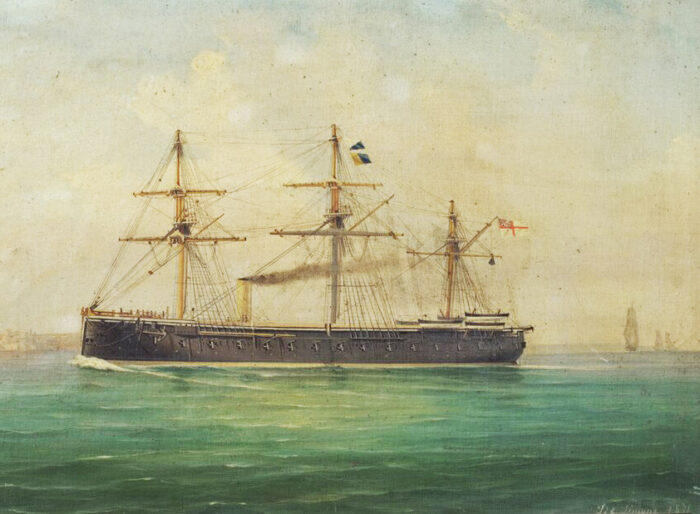
HMS Royal Oak
HMS Royal Oak was the first British wooden-hulled ironclad, laid down as 91-gun ship of the line. Her conversion to a 36-gun ironclad was approved 14 May 1861. She was cut down by one deck and lengthened on the stocks by 6.4 meters in order to accommodate her new armament on a dingle deck, with her original bow and stern modified to the same ironclad shape as her half-sisters with a straight stem, rounded stern. She was originally designed to carry thirty-six 68pdr SBML guns, but she was completed with a Breach Loading and Smoothbore Muzzle Loaders mix. As completed, Royal Oak was barque-rigged, sporting a 2,320m² sail area. In 1866, she was converted to ship rig, with a topgallant forecastle added in 1867.
Laid down at Chatham NYd on 1.5.1860 she was launched on 10.9.1862 and completed on 28.5.1863. Sold 9.1885
Her side armour was extended to the full length, being 4.5 inches or 114 mm amidships and 2.5 inches or 63mm at the ends. The wooden hull behind the armour was made or teak planking to stop shrapnel, and backed by 711 mm thick oak to absorb these.
Modernizations:
In 1867, HMS Royal Oak was rearmed with four 8-inches or 203mm/15 MLR Mk III, and twenty 7 inches or 178mm/16 MLR Mk III rifle breech loader (RBL)
⚙ Royal Oak specifications |
|
| Displacement | Displacement 6,366 long tons |
| Dimensions | Length 273 ft 1 in x 58 ft 5 in x 27 ft 6 in (83.2 x 17.8 x 7.31 m) |
| Propulsion | 1 shaft 2-cyl. HSE RCR, 6 rect. boilers: 3,708 ihp (2,800 kW) |
| Speed | 12.5 knots (23 km/h; 15 mph) |
| Range | 550t coal, 2,200 nmi (3,800 km; 2,500 mi) at 5 kn (9.3 km/h; 5.8 mph) |
| Armament | 11 × 110 pdr (183mm/17) BL, 24x 8-in/15 (68 pdr) 95 cwt SBML |
| Protection | Belt 2.5–4.5 in (63–114 mm), Battery 3–4.5 in (76–114 mm) |
| Crew | 585 |
Career of Prince Consort class ironclad
 HMS Prince Consort (1862)
HMS Prince Consort (1862)
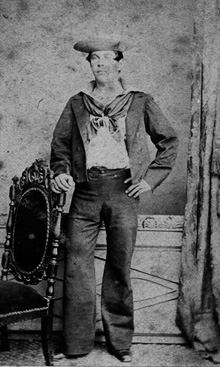 HMS Prince Consort was laid down on 13 august 1860 at HM Royal Dockyard, Pembroke, launched on 26 June 1862 and commissioned on April 1864. She was the first ship of that name in the Royal Navy. Laid down as HMS Triumph at HM Royal Dockyard, Pembroke, as a 91-gun screw second-rate ship of the line, she was renamed HMS Prince Consort on 14 February 1862 after the death of Prince Albert of Saxe-Coburg and Gotha, husband of Queen Victoria.
HMS Prince Consort was laid down on 13 august 1860 at HM Royal Dockyard, Pembroke, launched on 26 June 1862 and commissioned on April 1864. She was the first ship of that name in the Royal Navy. Laid down as HMS Triumph at HM Royal Dockyard, Pembroke, as a 91-gun screw second-rate ship of the line, she was renamed HMS Prince Consort on 14 February 1862 after the death of Prince Albert of Saxe-Coburg and Gotha, husband of Queen Victoria.
After commission, she was posted to Liverpool but took an Irish Sea gale, rolled badly, and it was found she did not have enough scuppers fitted in order to discharge seawater seeping in. The whole crew was put to contribution to scoop water out by all means, and she and almost foundered. She was assigned to the Channel Fleet from 1864 until 1867, until paid off to re-arm. From 1867 to 1871 she joined the Mediterranean Fleet, until sailing back to the Yard for a further re-armament. Despite this was done it was decided to keep her in reserve thereafter, as she saw no further sea service indeed. By 1882 and inspection revealed she had fallen into such a poor state it was no longer whether her restoration into working order, and added with the worries about the state of her wooden hull, she was put on the disposal list and sold for BU. Prince Consort indeed gained the reputation of the second-worst roller in the entire Royal Navy, being exceeded in this only by her near sister HMS Lord Clyde.
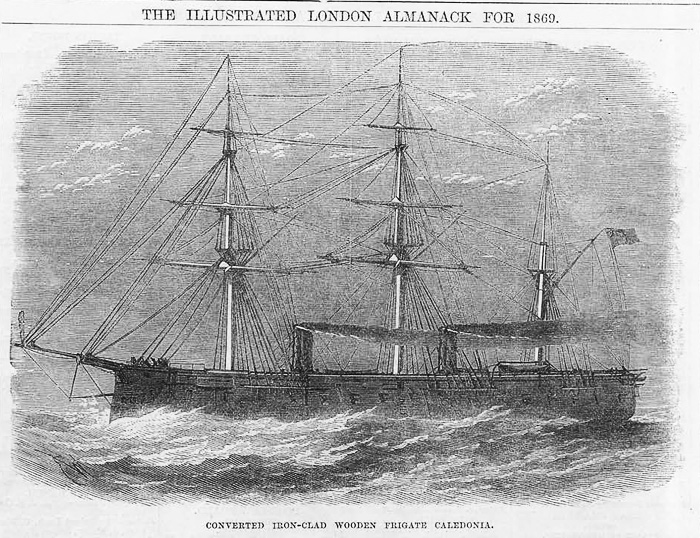
Caledonia on the Illustrated London Almanack 1869
 HMS Caledonia (1862)
HMS Caledonia (1862)

HMS Caledonia was laid down on 10 October 1860 at Woolwich Dockyard, launched on 24 October 1862 and commissioned in April 1865. She was one of a broadside ironclad of the Prince Consort class, originally laid down as a two-decker steam ship of the line, 91-gun Bulwark class, converted on the building stocks, into an armoured frigate, on the same design as all four others, but with a modern powerplant. She was commissioned as Second-in-Command, Mediterranean Fleet, and first ever armoured flagship of the Royal Navy.
Temporarily withdrawn from service in 1866 she was rebuilt to receive a poop deck. She returned as flagship, this time of the Channel Fleet until 1867, and paid off for re-armament.
She then became flagship of the Mediterranean Fleet until 1869, relieving HMS Victoria, the last three-decker flagship, and remained in that service until 1872. In July 1871 however, she ran aground off Santorini, in Greece. Later refloated, she was repaired in Malta. Back home unlike her sisters which were places into reserve, she became guardship in the Firth of Forth from 1872 until 1875 (allegedly). In between on 15 June 1873 Caledonia collided with the British ship Hogton Tower, off St. Alban’s Head in Dorset. The latter was severely damaged on her bow. Caledonia towed her in to Spithead for repairs, Caledonia next was assigned as Coastguard vessel at Birkenhead in Cheshire. She sailed to Portsmouth for a forthcoming inspection of the fleet, by the Shah of Persia. She was then at last paid off at Plymouth, laid up until she sold for scrap on 30 September 1886.
 HMS Ocean (1863)
HMS Ocean (1863)
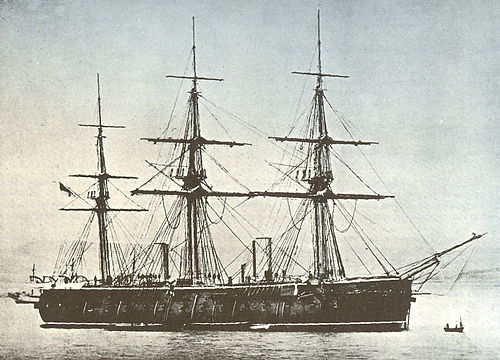
HMS Ocean was laid down on 23 August 1860 at Devonport Dockyard, launched on 19 March 1863 and commissioned in July 1866 at a cost of £298,851. She was the last of the Royal Navy’s four Prince Consort-class ironclads completed, like the others, originally laid down as a 91-gun second-rate ship of the line, converted during construction, and she spent the bulk of her career on the China Station as flagship and returning home 1872. Her initial career however was with the Channel Fleet, albeit she was almost immediately transferred to the Mediterranean, and from there to the Far East, reaching Batavia (Jakarta) on 15 October 1867. She was also the first armoured ship ever to double the Cape of Good Hope under sail. She set a record for ironclads in that guise, making 243 nautical miles (450 km; 280 mi) with cold boilers on 26 August 1867, the greatest distance ever covered by a British ironclad, showing the excellence of their rigging.
Ocean remained with the China Station for five years, 1867–1872 and never went into dry-dock maintenance. She was relieved the old HMS Rodney as station flagship in 1869 under Vice-Admiral Henry Kellett. She swapped crew for one from HMS Donegal and Captain William Hewett took command. In 1871, she ran down and sunk a large Chinese smuggling junk at Amoy. Ocean was relieved in turn by HMS Iron Duke in 1872. While she crossed the Suez Canal her poor state of her hull started to show, she was very slow and leaked. The Admiralty ordered that she returned instead via the Cape of Good Hope under steam. With her heavy fouling, she only could do 4.5 knots (8.3 km/h). While she proceeded, her sheathing was in a sorry state as well, her planking was in a very bad state given the tropical climate. Upon inspection, she was relegated to dockyard reserve until sold in 1882, BU at Charlton. Her stern decoration ended in Millbank, London, decorating Castle’s yard entrance.
 HMS Royal Oak (1862)
HMS Royal Oak (1862)
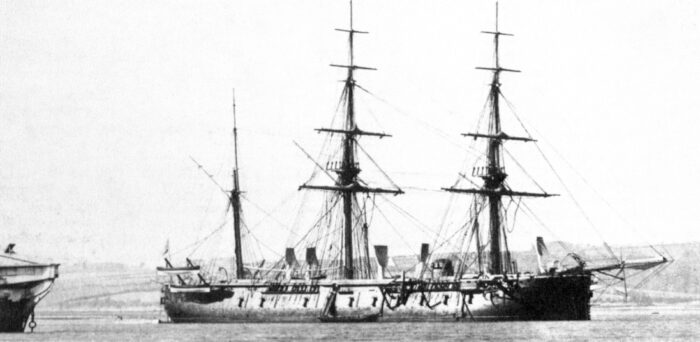
HMS Royal Oak was laid down on 1st May 1860 at Chatham Dockyard, launched on 10 September 1862 and commissioned in April 1863. She was considered as a near-sister of the Prince Consort-class armoured frigate and the lead ship in class, having the same base of conversion but a different engine and boiler arrangements which were inherited from her initial 91 gun requirements. In short, she was not equipped with a more modern powerplant as were her sisters. But like them, she was converted into an ironclad from a wooden ship of the line under construction and inherited the same issues resulting from it, notably she rolled a lot.
She spent most of her career with the Mediterranean Fleet, and briefly served with the Channel Fleet. She was back home in 1871 for a refit, but was instead placed in reserve in order to save money given the reputation of the class. Fourteen years later, she was still in reserve. An inspection revealed her general state and the state of her wooden hull was not worth her modernization, and she was sold for scrap in 1885.
None her sisters reached 1890.
In conclusion, the Prince Consort/Royal Oak class were considered an emergency solution to match the rapid rise of the French Ironclad fleet, being able to have at least twice as much of these in a short time. That included converting many wooden steamships of the line if needed, resulting in disappointing results as expected contrary to a new built. That resulted in turn to average seaworthiness, and a shortened active life of about eight-nine years. They were kept in reserve afterwards only an insurance, but in 1880 it was clear they were not worth a modernization.
Read More/Src
Books
Ballard, G. A., Admiral (1980). The Black Battlefleet. Annapolis, Maryland: Naval Institute Press. ISBN 0-87021-924-3.
Baxter, James Phinney The Introduction of the Ironclad Warship, published Harvard University, 1933.
David K. Brown (30 April 1997). Warrior to dreadnought. Naval Institute Press. ISBN 978-1-86176-022-7.
Clowes, William Laird Four Modern Naval Campaigns, Historical Strategical, and Tactical, first published Unit Library, 1902, reprinted Cornmarket Press, 1970.
Andrew Lambert (24 September 1984). Battleships in transition. ISBN 978-0-85177-315-5.
Parkes, Oscar (1990) [1957]. British Battleships. Annapolis, Maryland: Naval Institute Press. ISBN 1-55750-075-4.
Roberts, John (1979). “Great Britain (including Empire Forces)”. In Chesneau, Roger & Kolesnik, Eugene M. (eds.). Conway’s All the World’s Fighting Ships 1860–1905. New York: Mayflower Books. pp. 1–113. ISBN 0-8317-0302-4.
Reed, Edward J Our Ironclad Ships, their Qualities, Performance and Cost, published John Murray, 1869.
Links
navypedia.org/ royal_oak.html
navypedia.org/ prince_consort.html
en.wikipedia.org HMS_Royal_Oak_(1862)
en.wikipedia.org/ HMS_Prince_Consort
Videos
None
Model Kits
None


 Latest Facebook Entry -
Latest Facebook Entry -  X(Tweeter) Naval Encyclopedia's deck archive
X(Tweeter) Naval Encyclopedia's deck archive Instagram (@navalencyc)
Instagram (@navalencyc)





 French Navy
French Navy Royal Navy
Royal Navy Russian Navy
Russian Navy Armada Espanola
Armada Espanola Austrian Navy
Austrian Navy K.u.K. Kriegsmarine
K.u.K. Kriegsmarine Dansk Marine
Dansk Marine Nautiko Hellenon
Nautiko Hellenon Koninklije Marine 1870
Koninklije Marine 1870 Marinha do Brasil
Marinha do Brasil Osmanlı Donanması
Osmanlı Donanması Marina Do Peru
Marina Do Peru Marinha do Portugal
Marinha do Portugal Regia Marina 1870
Regia Marina 1870 Nihhon Kaigun 1870
Nihhon Kaigun 1870 Preußische Marine 1870
Preußische Marine 1870 Russkiy Flot 1870
Russkiy Flot 1870 Svenska marinen
Svenska marinen Søværnet
Søværnet Union Navy
Union Navy Confederate Navy
Confederate Navy Armada de Argentina
Armada de Argentina Imperial Chinese Navy
Imperial Chinese Navy Marinha do Portugal
Marinha do Portugal Mexico
Mexico Kaiserliche Marine
Kaiserliche Marine 1898 US Navy
1898 US Navy Sovietskiy Flot
Sovietskiy Flot Royal Canadian Navy
Royal Canadian Navy Royal Australian Navy
Royal Australian Navy RNZN Fleet
RNZN Fleet Chinese Navy 1937
Chinese Navy 1937 Kriegsmarine
Kriegsmarine Chilean Navy
Chilean Navy Danish Navy
Danish Navy Finnish Navy
Finnish Navy Hellenic Navy
Hellenic Navy Polish Navy
Polish Navy Romanian Navy
Romanian Navy Turkish Navy
Turkish Navy Royal Yugoslav Navy
Royal Yugoslav Navy Royal Thai Navy
Royal Thai Navy Minor Navies
Minor Navies Albania
Albania Austria
Austria Belgium
Belgium Columbia
Columbia Costa Rica
Costa Rica Cuba
Cuba Czechoslovakia
Czechoslovakia Dominican Republic
Dominican Republic Haiti
Haiti Hungary
Hungary Honduras
Honduras Estonia
Estonia Iceland
Iceland Eire
Eire Equador
Equador Iran
Iran Iraq
Iraq Latvia
Latvia Liberia
Liberia Lithuania
Lithuania Mandchukuo
Mandchukuo Morocco
Morocco Nicaragua
Nicaragua Persia
Persia San Salvador
San Salvador Sarawak
Sarawak Uruguay
Uruguay Venezuela
Venezuela Zanzibar
Zanzibar Warsaw Pact Navies
Warsaw Pact Navies Bulgaria
Bulgaria Hungary
Hungary

 Bundesmarine
Bundesmarine Dutch Navy
Dutch Navy Hellenic Navy
Hellenic Navy Marina Militare
Marina Militare Yugoslav Navy
Yugoslav Navy Chinese Navy
Chinese Navy Indian Navy
Indian Navy Indonesian Navy
Indonesian Navy JMSDF
JMSDF North Korean Navy
North Korean Navy Pakistani Navy
Pakistani Navy Philippines Navy
Philippines Navy ROKN
ROKN Rep. of Singapore Navy
Rep. of Singapore Navy Taiwanese Navy
Taiwanese Navy IDF Navy
IDF Navy Saudi Navy
Saudi Navy Royal New Zealand Navy
Royal New Zealand Navy Egyptian Navy
Egyptian Navy South African Navy
South African Navy






























 Ukrainian Navy
Ukrainian Navy dbodesign
dbodesign